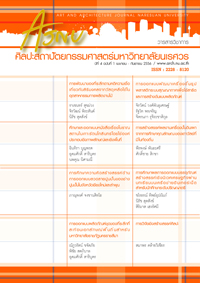การสร้างสรรค์ผลงานเครื่องปั้นดินเผาจากการศึกษาคุณลักษณะของเถาวัลย์ที่มีในท้องถิ่น
Main Article Content
Abstract
การวิจัยในครั้งนี้มีวัตถุประสงค์ 4 ประการ คือ 1) ศึกษาลักษณะทางกายภาพของพืชประเภทเถาวัลย์ ที่มีในท้องถิ่น 2) ศึกษารูปแบบของการใช้พืชประเภทเถาวัลย์ ในการสร้างสรรค์ผลงานในลักษณะต่างๆ 3) ทดลองและศึกษาการสร้างรูปแบบ แนวคิด เทคนิค วิธีการในการนำดินไปสร้างสรรค์เป็นผลงานเครื่องปั้นดินเผาโดยการศึกษาคุณลักษณะของเถาวัลย์ที่มีในท้องถิ่น 4) สร้างสรรค์ผลงานเครื่องปั้นดินเผาที่มาจากการศึกษาคุณลักษณะของเถาวัลย์ที่มีในท้องถิ่น ตามกรอบการศึกษาวัสดุและ กระบวนการผลิตเครื่องปั้นดินเผาและสำรวจข้อมูลเกี่ยวกับเถาวัลย์ในท้องถิ่นโดยมีกลุ่มตัวอย่าง คือ กลุ่มผู้ผลิตตะกร้าเถาวัลย์ บ้านอีเซ ตำบลอีเซ อำเภอโพธิ์ศรีสุวรรณ จังหวัดศรีษะเกษและกลุ่มผลิตภัณฑ์เครื่องปั้นดินเผาบ้านหม้อ ตำบลเขวา อำเภอ เมือง จังหวัดมหาสารคาม จากการวิจัยในครั้งนี้พบว่า ลักษณะของพืชประเภทเถาวัลย์มีคุณค่าความงามในหลายด้าน เช่น พื้นผิว ลีลา หรือเส้น การบิดพัน ขนาดที่แตกต่าง และสีสัน นอกจากนี้ยังพบว่าเถาวัลย์ได้เข้ามามีบทบาทในงานศิลปะ ประเภท สถาปัตยกรรม และศิลปประยุกต์ มีจุดเด่นคือ การใช้รูปแบบที่ลดทอนจากธรรมชาติ และบางส่วนใช้ร่วมกับพืชชนิดอื่น เพื่อให้เกิดความสวยงาม การศึกษาและพัฒนาเนื้อดินในการขึ้นรูปผลิตภัณฑ์จากลักษณะของเถาวัลย์ ผู้วิจัยได้เลือกรูปทรงของ ลูกน้ำเต้า นมวัว สะบ้าและลักษณะรูปทรงของต้นไม้ กิ่งไม้ที่มีลักษณะกลมกลืนกับลักษณะของเถาวัลย์โดยใช้การเลือกแบบ ง่าย มาประยุกต์ใช้ในการออกแบบผลิตภัณฑ์เครื่องปั้นดินเผาในครั้งนี้ ผลสรุปจากการสร้างสรรค์ผลงานเครื่องปั้นดินเผาจาก การศึกษาคุณลักษณะเถาวัลย์ที่มีในท้องถิ่น ผู้วิจัยสามารถสรุปได้ว่า พืชประเภทเถาวัลย์มีคุณค่าความงามในด้าน พื้นผิว จังหวะ ลีลา หรือเส้น การบิดพัน ขนาดสัดส่วนรวมทั้งสีสันที่แตกต่าง และดินที่ผสมตามสัดส่วน ฟางข้าว : ดินบ้านหม้อ : ดินเชื้อ ใน อัตราส่วน 20:70:10 เมื่อนำไปขึ้นรูปแบบกดแล้วไม่หดตัว สามารถคงรูปได้และเมื่อนำไปเผาแล้วทนความร้อน ไม่แตกหักและ สามารถเลียนแบบลักษณะทางกายภาพของเถาวัลย์ในท้องถิ่นได้ และใช้งานได้จริง กรรมวิธีการผลิตสามารถผลิตได้โดยช่าง พื้นบ้านสามารถนำไปต่อยอดเพื่อการผลิต และจำหน่ายได้
Pottery Making Based on a Study of the Properties of Local Vines
The objectives of this research were fourfold: (1) to study the physical properties of local vines; (2) to study the ways in which vine plants are used in many forms of work; (3) to conduct the experiments of forms, concepts, techniques, and making of clay ornament sculpting based on local vines study; and (4) to make ceramic sculpture following the aforementioned study, a framework of clay material and production process study, and a survey on local vines. In this research, the sample was drawn from a group of local vine basket makers in Ban I Se, I Se sub-district, Pho Si Suwan district, Sisaket Province and a set of pottery products from Ban Mo, Khwao sub-district, Muang district, Maha Sarakham Province. Results showed that the aesthetic value of the local vines derived from their texture, styles or stems, twinning patterns, size varieties, and colors. With an artistic character, vines have appeared in thai architecture and applied arts ornamental. The outstanding property of vine plants is that their natural forms or shapes can be simplified and made into intricate curvy patterns and lines. In developing of clay body for making clay ornament , the researcher chose the original shapes of gourds, udders, Thai native plants called sabas (Entada rheedii Spreng), trees, and tree branches which features resemble vines. The findings of the research showed that when formed with the pressing mold method, the clay was mixed with 20, 70, and 10 percent of rice straw, Ban Mo clay, and grog mixed respectively. which made the bisque did not shrink and still retained its form.The properties of the clay was still able to tranfer the shape and the detail from the original vines as well. The sculpting processes invented by this research can be further used or developed by local pottery makers for pottery production and trade purposes.


